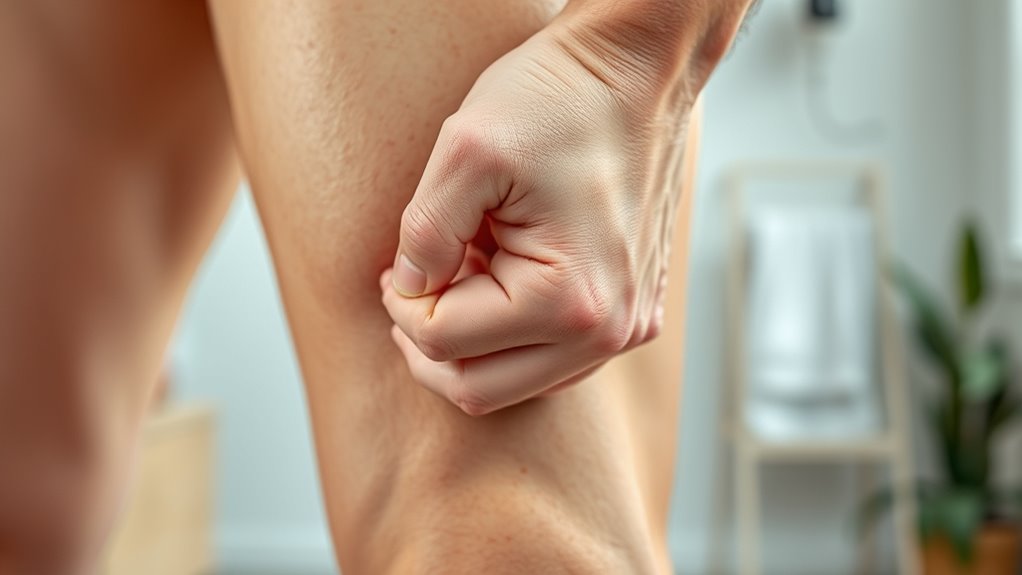Muscle spasms are sudden, involuntary contractions that cause pain and disrupt your movements. Common causes include electrolyte imbalances, dehydration, overuse, nerve compression, or certain medications. To ease them, stay hydrated, eat potassium-rich foods, stretch regularly, and apply heat or cold packs. If spasms happen often, become severe, or persist despite self-care, it’s important to see a healthcare professional. Keep exploring to learn more about effective strategies and underlying causes.
Key Takeaways
- Muscle spasms are sudden, involuntary contractions that cause pain and disrupt movement.
- Common causes include electrolyte imbalances, dehydration, nerve compression, overuse, and medical conditions.
- Preventative measures involve proper hydration, balanced electrolytes, stretching, and avoiding muscle overexertion.
- Treatments include applying heat or cold packs, stretching, hydration, and medications if prescribed by a doctor.
- Seek medical attention for frequent, severe, or persistent spasms or if an underlying condition is suspected.

Muscle spasms are sudden, involuntary contractions that can cause discomfort and disrupt your daily activities. These involuntary twitches often catch you off guard, sometimes occurring during rest or physical activity. To understand what causes these spasms, you need to consider factors like electrolyte imbalance and nerve compression. An electrolyte imbalance, which occurs when your levels of minerals like potassium, magnesium, or calcium are off, directly affects how your muscles function. When these minerals are out of balance, your muscles can become hyperexcitable, leading to spasms. For instance, sweating excessively during exercise or losing fluids through illness can deplete your electrolytes, increasing your risk of spasms. On the other hand, nerve compression—such as from a herniated disc or pinched nerve—can interfere with nerve signals that control muscle movements, causing sudden contractions. If a nerve is compressed or irritated, it may send errant signals to your muscles, triggering spasms that can be painful and persistent.
Beyond these primary causes, dehydration plays a significant role in muscle spasms. When you’re dehydrated, your body struggles to maintain proper electrolyte levels, which can result in muscle twitching and cramps. Additionally, overuse or strain of a muscle can lead to fatigue and spasms, especially if you push your muscles beyond their limits or perform repetitive motions without adequate rest. Certain medical conditions, like peripheral neuropathy or metabolic disorders, also predispose you to muscle spasms by affecting nerve function or muscle health. Medication side effects, particularly diuretics or statins, may also alter electrolyte levels or muscle responsiveness, increasing spasm likelihood.
To prevent and treat muscle spasms, staying well-hydrated and maintaining a balanced intake of electrolytes is essential. Incorporate foods rich in potassium and magnesium, such as bananas, leafy greens, and nuts, into your diet. Stretching before and after physical activity can reduce muscle fatigue and the chance of spasms. If nerve compression is suspected, consulting a healthcare professional for diagnosis and possible intervention is crucial. They might recommend physical therapy, medications, or other treatments to relieve compression and restore normal nerve function. Applying heat or cold packs can also help soothe irritated muscles and reduce spasm severity. In cases where spasms are frequent, severe, or persistent, seeking medical advice is essential to identify underlying causes and tailor appropriate treatment. Remember, addressing electrolyte imbalances, avoiding overexertion, and managing nerve health are key steps to minimizing muscle spasms and keeping your muscles functioning smoothly.
Frequently Asked Questions
Can Muscle Spasms Indicate a Serious Medical Condition?
Muscle spasms can sometimes indicate serious underlying conditions, especially if they’re severe, persistent, or accompanied by emergency symptoms like chest pain, weakness, or numbness. If you experience these warning signs, you should seek medical attention promptly, as they could signal a more serious health issue. While most spasms are harmless, it’s important to monitor your symptoms and consult a healthcare professional if you’re concerned.
Are There Specific Exercises to Prevent Muscle Spasms?
You can prevent muscle spasms by incorporating regular stretching routines and strength training into your fitness plan. Focus on stretching major muscle groups before and after workouts to maintain flexibility, and include strength exercises to build muscle endurance. Stay hydrated and avoid overexertion. Consistent routines help your muscles stay balanced and reduce the likelihood of spasms, keeping you active and comfortable.
How Do Diet and Hydration Influence Muscle Spasms?
Imagine your muscles as a well-oiled machine, needing the right fuel. Proper diet and hydration keep your electrolyte balance steady, preventing spasms. Drinking enough water and using hydration strategies guarantee your muscles stay supple and responsive. When you stay hydrated, you help your body flush out toxins and maintain mineral levels, reducing the chances of painful spasms. Prioritize electrolyte-rich foods and consistent hydration to keep your muscles relaxed and functioning smoothly.
When Should I See a Doctor for Frequent Spasms?
You should see a doctor if you experience frequent spasms, especially if they persist despite resting, stretching, or staying hydrated. These spasms could signal an electrolyte imbalance or muscle strain that needs professional assessment. Seek medical attention promptly if spasms are severe, linked to injury, or accompanied by swelling, weakness, or numbness, as these might indicate underlying issues requiring targeted treatment.
Are Muscle Spasms More Common in Certain Age Groups?
You might notice that age-related spasms are more common as you get older, especially in seniors, due to muscle loss and nerve changes. Adolescents often experience muscle cramps from growth spurts or intense activity. Younger children may also get cramps, though less frequently. Factors like dehydration, electrolyte imbalances, and physical activity influence how often you experience spasms across different age groups. Stay hydrated and stretch regularly to help prevent them.
Conclusion
Remember, an ounce of prevention is worth a pound of cure. Staying hydrated, stretching regularly, and listening to your body can help prevent muscle spasms. If you do experience one, gentle stretching and proper rest often do the trick. Don’t ignore recurring or severe spasms—they might be your body’s way of signaling something more serious. By taking small steps now, you can keep your muscles healthy and avoid bigger issues down the road.









